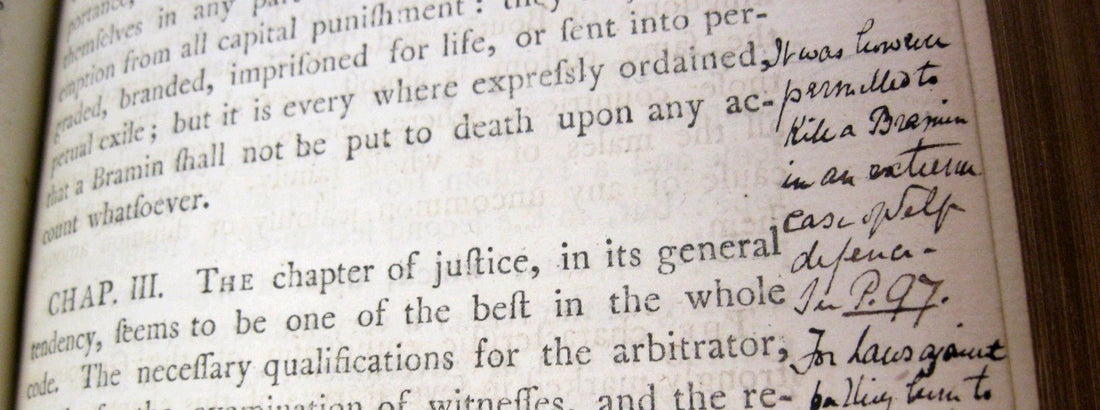Do you write in your books? Underline or highlight passages, make a little note about the content...? There are competing philosophies for and against such practices. Generally speaking I think it's a great way to engage with the text. It's also a great way to get to know former readers. Researchers love marginalia because it can tell them a lot about how people read, hundreds of years ago, and what was important to the people of the era.

I'm going to guess you've never written a confession of murder in the margins of one of your books. Let's get some context:
The book is The Code of Gentoo Laws, or Ordinations of the Pundits, From a Persian Translation, made from the original, written in the Shanscrit Language. Second printing. This is the 1777 edition, London, which is said to be a pirated edition. The book was originally published in 1776, privately printed by the East India Company, and an official second edition came out in 1781. The book was commissioned by Warren Hastings of the East India Company, and was compiled with the help of eleven pandits/Brahmin scholars, and translated by Nathaniel Brassey Halhed, with the aim of being used by members of the East India Company. Includes several plates of selected Sanskrit writings, some of which fold-out.
There is a modern pencil notation in the front that claims the book is "Henry Buckle's copy according to earlier bookseller notations". These notations must have been on a separate slip of paper and are now lost. There are some notes/marginalia scattered throughout the book, and a couple pages of notes bound-in at the front. The subject of the book and the marginalia therein do seem to coincide with the studies of Henry Thomas Buckle, who wrote A History of Civilization in England and worked on, but never finished, a broader work on the subject of the history of civilization, for which A Code of Gentoos would have served as reference. If this was Buckle, the notes would likely have been made in the 1840s-1850s. However, from the little I've read about Buckle it seems he didn't actually travel a whole lot so the likelihood of him getting into a situation as described below seems dubious, which only leaves it more of a mystery who the annotator was.
Whoever he was, there are some very curious notations, particularly on page LV of the preface. The paragraph to which the note refers concludes: "...but it is everywhere expressly ordained that a Brahmin shall not be put to death upon any account whatsoever." To which is written in the margin: "I was however permitted to kill a Brahmin in an ____(?) case of self defence."
Murder! Sanctioned or not, that's an admission of murder right there!
None of the other notes, so far as I can make them out, contain anything nearly so salacious. Still, hereby hangs a tale that will never be heard, unless there are sources somewhere in the world I am not privy to.

